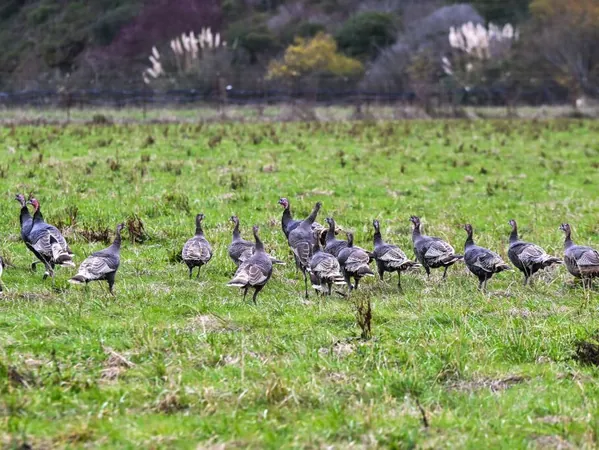
Bird Flu Alert: Essential Guidance to Safeguard Yourself and Your Furry Friends
2024-12-30
Author: Rajesh
Avian influenza, commonly referred to as bird flu, is currently impacting dairy herds in California, and several individuals in North America have fallen seriously ill. Recent research has identified a mutation in the virus that could enhance its ability to thrive in the human respiratory system. Despite these developments, health experts suggest that the public should remain calm and not overly anxious about the virus, at least for the time being.
"We are on heightened alert," states Benjamin Anderson, an infectious disease epidemiologist from the University of Florida. "Communicating this situation effectively is quite challenging."
Concerns regarding the H5N1 strain of bird flu potentially triggering a pandemic have loomed for decades. While previous strains have proven fatal to humans, the current outbreak—designated as clade 2.3.4.4b—has thus far resulted in mild human infections connected primarily to close contact with infected animals.
Nonetheless, there are two alarming reminders highlighting that vigilance is essential: A hospitalized teenager in Canada and a Louisiana resident, both of whom had close exposure to infected birds. Genetic investigations revealed mutations may have occurred as the virus replicated within these individuals, but notably, there is no current evidence of human-to-human transmission.
Richard Webby, a virologist researching avian influenza at St. Jude Children's Research Hospital, emphasizes the unpredictability of the virus and its capacity for evolution. "It’s difficult to ascertain how much warning we might have when changes begin," he cautions.
Should You Fear Catching Bird Flu?
Experts advise that despite the widespread nature of this highly pathogenic avian influenza strain, it is still primarily a virus affecting birds. Nearly all of the cases reported in the U.S. derived from direct handling of infected poultry, wild birds, or dairy cattle. If you’re not in close contact with these animals, your risk of infection from the current strain remains minimal.
Unlike seasonal flu viruses, bird flu does not readily infect the upper airways of humans but targets deeper lung receptors. This difference explains the presentation of many recent cases, which include symptoms like conjunctivitis. “This virus is not very efficient at infecting people,” Anderson notes. “Typically, significant exposure is necessary for infection to occur.”
There have been a few cases in California, Missouri, and British Columbia with unknown origins, but again, there's no evidence of transmission from person to person.
Understanding "Close Contact"
Poultry workers have primarily encountered bird flu while culling infected flocks—a high-risk task due to prolonged exposure to airborne viral particles from saliva, mucus, and excrement. Historical cases often trace back to live bird markets where extensive handling of birds occurs.
What about everyday interactions with wild birds? Unless you're actively handling birds, simple passersby interactions hold a very low risk.
Should You Stop Using Your Bird Feeder?
For the general public, it's improbable that casual contact with bird droppings or feeders would result in infection, although caution is always wise. The virus has been known to survive under certain conditions, so basic hygiene is advisable.
For those caring for backyard flocks, maintain a distance from wild birds to reduce risk, and consider wearing protective masks if necessary.
Concerns with Dairy Cattle and Milk
The emergence of bird flu in dairy cattle seemed sudden and alarming, leading to approximately 40 dairy workers becoming infected. Fortunately, pasteurization effectively neutralizes the virus in milk and eggs. However, researchers have advised against consuming raw milk due to potential infections.
Protecting Your Pets
The principles for preventing bird flu in humans also apply to pets. Monitor outdoor activities for cats and dogs, ensuring they stay away from wild birds and unprocessed meats. Stray animals can carry the virus, putting your pets at risk.
Epicenters of concern have emerged—such as a cat succumbing to the virus after eating contaminated raw food. Notably, dogs are also susceptible, with documented cases of canine infections occurring.
While instances of feline-to-human transmission are few, vigilance is key. Should your pet exhibit unusual behaviors akin to rabies, consult a veterinarian promptly.
Ultimately, there is no immediate cause for panic regarding your pet's exposure to H5N1. Awareness and basic precautions—such as avoiding high-risk contacts—are the best strategies to protect yourself and your beloved animals in this ongoing situation. Stay informed and proactive as developments unfold in the realm of avian influenza.




 Brasil (PT)
Brasil (PT)
 Canada (EN)
Canada (EN)
 Chile (ES)
Chile (ES)
 Česko (CS)
Česko (CS)
 대한민국 (KO)
대한민국 (KO)
 España (ES)
España (ES)
 France (FR)
France (FR)
 Hong Kong (EN)
Hong Kong (EN)
 Italia (IT)
Italia (IT)
 日本 (JA)
日本 (JA)
 Magyarország (HU)
Magyarország (HU)
 Norge (NO)
Norge (NO)
 Polska (PL)
Polska (PL)
 Schweiz (DE)
Schweiz (DE)
 Singapore (EN)
Singapore (EN)
 Sverige (SV)
Sverige (SV)
 Suomi (FI)
Suomi (FI)
 Türkiye (TR)
Türkiye (TR)
 الإمارات العربية المتحدة (AR)
الإمارات العربية المتحدة (AR)